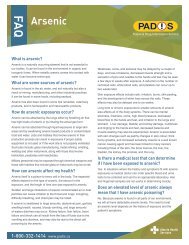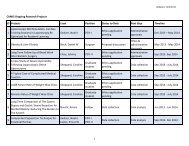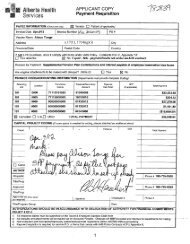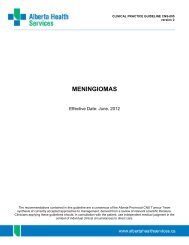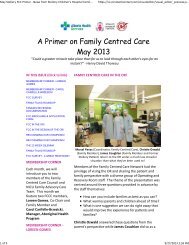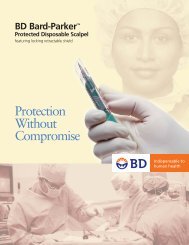EXTRAGONADAL GERM CELL TUMOURS - Alberta Health Services
EXTRAGONADAL GERM CELL TUMOURS - Alberta Health Services
EXTRAGONADAL GERM CELL TUMOURS - Alberta Health Services
Create successful ePaper yourself
Turn your PDF publications into a flip-book with our unique Google optimized e-Paper software.
BACKGROUND<br />
CLINICAL PRACTICE GUIDELINE GU-007<br />
Version 1<br />
Germ cell tumours (GCTs) are one of the most common cancers among young adult men. 1 An<br />
extragonadal GCT is, by definition, a germ cell neoplasm displaying one of the histologies associated with<br />
gonadal origin, but located outside the gonads. 2 Extragonadal GCTs are relatively uncommon, but<br />
represent 1 to 5% of all GCTs. 3 Non-central nervous system extragonadal GCTs are found in a variety of<br />
anatomic locations, but most commonly affect the mediastinum and retroperitoneal. 2<br />
The mediastinum is the most common anatomic site for extragonadal germ cell tumours in adults. 3 Data<br />
on GCT etiology suggest that mediastinal GCTs comprise approximately 54% of all extragonadal GCT<br />
cases, while retroperitoneal GCTs comprise the remaining 45%. 4-6 The majority of these cases occur in<br />
males aged 20 to 40 years. 7 When treated with induction chemotherapy, with or without secondary<br />
surgery, patients with pure seminomatous extragonadal GCTs have a long term cure rate of almost 90%,<br />
irrespective of the primary tumour site. Patients with mediastinal non-seminoma have a five-year survival<br />
rate of 45%, whereas patients with retroperitoneal primaries have a five-year survival rte of 62%. 8<br />
GUIDELINE QUESTION<br />
What are the appropriate management strategies for patients with primary mediastinal or retroperitoneal<br />
germ cell tumours?<br />
DEVELOPMENT AND REVISION HISTORY<br />
This guideline was reviewed and endorsed by the <strong>Alberta</strong> Provincial Genitourinary Tumour Team.<br />
Members of the <strong>Alberta</strong> Provincial Genitourinary Tumour Team include medical oncologists, radiation<br />
oncologists, urologists, pathologists, nurses, and pharmacists. Evidence was selected and reviewed by a<br />
working group comprised of members from the <strong>Alberta</strong> Provincial Genitourinary Tumour Team and a<br />
Knowledge Management Specialist from the Guideline Utilization Resource Unit. A detailed description of<br />
the methodology followed during the guideline development process can be found in the Guideline<br />
Utilization Resource Unit Handbook.<br />
SEARCH STRATEGY<br />
The Pubmed database was searched using the terms (retroperitoneal OR mediastinal) AND germ cell<br />
AND primary, published between 1946 and 2012 April. Results were limited to clinical trials, studies in<br />
humans, meta-analyses, and practice guidelines. The Medline database was then searched for relevant<br />
literature using the MeSH terms “Neoplasm, germ cell and embryonal” with subheadings drug therapy,<br />
radiotherapy, therapy, and surgery, combined with “extragonadal.” Results were limited to literature<br />
published between 1946 and 2012 April. Studies involving fewer than ten patients with extragonadal germ<br />
cell tumours, as well as single case studies, were excluded.<br />
Websites of the following guideline developers were searched for relevant guidelines: National<br />
Comprehensive Cancer Network (NCCN), British Columbia Cancer Agency (BCCA), European Society of<br />
Medical Oncology (ESMO), National Institutes of <strong>Health</strong> and Clinical Excellence (NICE), American Society<br />
of Clinical Oncology (ASCO), Scottish Intercollegial Guidelines Network (SIGN), Cancer Council Australia<br />
(CCA) and Cancer Care Ontario (CCO).<br />
Page 2 of 8



